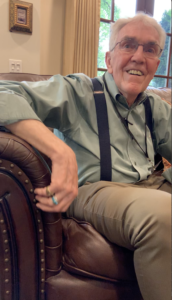
Andrew Hall conducted this interview with Neal E. Lambert in July 2022, at the Provo retirement community where Neal and his wife Ann are living. Ann also attended the interview.
Biographical sketch
Neal E. Lambert (b. 1934) grew up in Fillmore, Utah. He earned a bachelor’s degree at the University of Utah, where he studied Western literature under Don Walker (1917-1980) with his close friends Richard H. Cracroft and Levi S. Peterson. He continued his studies at Utah through a Ph.D. in American Studies, writing his dissertation on the western author Owen Wister. He taught at what is now Weber State University, then joined the BYU English Department faculty in 1966. He edited (with Richard Cracroft) two anthologies of Mormon Literature, A Believing People: Literature of the Latter-day Saints, published in 1974 to be a textbook for the Mormon Literature class, and 22 Young Mormon Writers (Communications Workshop, 1975). He was a founding member of the Association for Mormon Letters, and was the second AML president in 1977-1978. He served as the chair of BYU’s American Studies Program, Associate Academic Vice President for graduate studies and research (1982-1985), and chair of the English Department (1991-1994) . From 1987 until 1990 he was president of the North Carolina Raleigh Mission. During his tenure as English Department Chair, BYU faced debates over the extent of dissent allowed by faculty from LDS teachings, especially in the English Department.
A selected bibliography
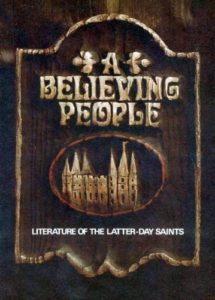 “Saints, Sinners, and Scribes: A Look at the Mormons in Fiction,” Utah Historical Quarterly 36: 1 (Winter 1968): 63-76. Won the 1968 Utah State Historical Society Award for best article.
“Saints, Sinners, and Scribes: A Look at the Mormons in Fiction,” Utah Historical Quarterly 36: 1 (Winter 1968): 63-76. Won the 1968 Utah State Historical Society Award for best article.
The article discusses non-Mormon authors like Arthur Canon Doyle who wrote about Mormons, what they got wrote, and the success of Maurine Whipple and Virginia Sorensen, who managed to get beyond stereotypes to find the humanity underneath.
“Owen Wister’s Virginian: The Genesis of a Cultural Hero.” Western American Literature 6.2 (1971): 99-107.
(with Richard H. Cracroft). “Through Gentile Eyes: A Hundred Years of the Mormon in Fiction,” in New Era, 2 (March 1972), 14-19.
(with Richard H. Cracroft). A Believing People: Literature of the Latter-day Saints. Brigham Young University Press, 1974. An anthology of Mormon literature, created to be the textbook of a BYU English class.
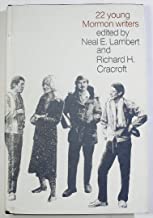 (with Richard H. Cracroft). 22 young Mormon Writers. Provo: Communications Workshop, 1975.
(with Richard H. Cracroft). 22 young Mormon Writers. Provo: Communications Workshop, 1975.
“The Representation of Reality in Nineteenth Century Mormon Autobiography.” Dialogue 11.2 (Summer 1978): 62-74.
(with Richard H. Cracroft). “Literary Form and Historical Understanding: Joseph Smith’s First Vision.” in Journal of Mormon History 7 (1980): 33-42.
(with Matthew Durant). “From Foe to Friend. The Mormon Embrace of Fiction.” in Utah Historical Quarterly 50 (Fall 1982): 325-39
Interview:
Tell me about your 1966 article “Saints, Sinners, and Scribes: A Look at the Mormons in Fiction.”
The Utah Historical Society came to me and asked me to write it. They wanted something on the image of Mormons in fiction. So we skimmed through some stuff and put it together.
At that point, were you aware of Whipple and Sorensen?
Yes, they were household names, as long as I could remember. But I never did really dive into their work. Well, we did read The Giant Joshua, definitely. The whole idea of a separate discipline of Mormon literature was beyond the pale, beyond anything we had imagined up to that point. Vardis Fisher was around, but no one dared teach about him. That had been pretty much back in the 1950s. I came to BYU in 1966. When you would float that term, Mormon literature, most members as a whole would say, Oh yes, we’ve got those books. Meaning the Out of the Best Books series. That was what they thought of as imaginative writing.
How did you think of creating the Mormon literature course at BYU?
We knew that the stuff was there. All you had to do was start reading, like Maurine Whipple. And Clinton Larson was calling from down the hall to us, he wanted recognition. And his stuff was good. There was enough for us to seriously teach a course. That is where we first got the idea for teaching the course. But we didn’t want to simply gather up stuff miscellaneously. That is what led to A Believing People.
And the book was made to be the textbook of course?
Yes, it was made for the course. It was not an attempt to be exhaustive or even representative. Then things began to move and grow from there.
I am trying to remember what was the difference between the course, which grew naturally in the English Department, and the Association for Mormon Letters. And I can’t really answer that. All I know is that there were enough people around, like Douglas Thayer and Clinton Larson in our department, and people outside of the department as well who were interested in Mormon literature. People were beginning around that time to seriously look at pioneer journals not just as history, but also as wonderful literary expressions. So, we saw that, and wanted to put it together. Then we wanted to carry on the discussion.
Were you modeling your study on the study of Jewish or Catholic literatures?
I don’t remember doing that. Dick Cracroft and I just wanted to get together with like-minded people to talk about it. Dick got me into BYU. We went through graduate school together at the University of Utah, shoulder-to-shoulder, Dick, and I, and Levi Peterson. We all studied under Don Walker (1917-1980), who was our intellectual godfather. He was the one that helped me, Dick, and Levi to sense there is really good stuff out there that is not part of the Freshman English anthology. So in his class we were reading mostly Western literature, including journals, but the same principles apply. If you are reading a cowboy’s memoir, and someone’s account of pulling a handcart over the black route down in St. George.
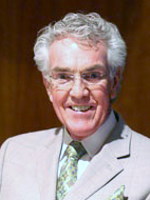
I was looking through Richard Cracroft’s papers at BYU, and saw references to “The Rocky Mountain Trapping and Literary Society” [which included Cracroft, Lambert, and Peterson, former students of Don Walker, who met in the 1960s and 70s to discuss Western literature.]
Right! And you get a sense of that if you come across The Possible Sack. I think there may be copies of it in the BYU archives [BYU appears to have 5 issues in the archives, 1969-1974]. “The Possible Sack” is an old mountain-man term. Instead of pockets, they would have a sack of “possibles”, their flint, and steel, knives and whatever they needed. We continued contact with Don, our mentor, kept monthly dialogues going, and created this amateur, self-published mimeographed journal. They give you an idea of the intellectual background we were coming from then, combining our Mormonism with our academic training. Our training was back in the late 1950s and early 1960s, a time when lots of ideologies were sweeping through universities. Someone said of those years that the only place you could find Marxism in America was in university English departments! (I’m not sure I should share all of this!) We remember reading some of these political discussions of American literature. I remember our professor [Walker], who took us out in the woods for seminars around the campfire. He said, “Well . . .do you want to know what I think about that?” We said yes, and he said, “It’s bullshit.” (Laughs). He was the model for honest, academic study and response.
Did he have a Mormon background?
Yes, although he was not active in the Church at all. He was born and grew up in Oak City, a small town in the foothills between Delta and Filmore, really small. After he graduated from the U, during the depression, he married and lived in a tent. Then he finally got enough money together to go to Minnesota, where he got his PhD in American Studies under Henry Nash Smith, one of the grandfathers of that discipline.
So, all of this is all the ocean from which we came. Out of this academic background, we were talking about who we are. Finding ways to talk about the world as LDS, which is profoundly significant. Some people wanted everything to be sweetness and light, and life isn’t all sweetness and light.
So, somewhere along the way we organized, and that was the beginning of our study of Mormon literature.
I didn’t realize you were friends with Levi Peterson that far back.
Yes, right from the very first. Levi and his wife were neighbors of ours in graduate school. So, we have been together even longer than Dick and I.
He recently put out a new collection of stories with Signature, Losing a Bit of Eden.
I’m not surprised. I have great admiration for him.
He was not as active in the Church, right?
Well, he was a missionary in France, when that mission really went over the edge, when some of the missionaries were preaching polygamy [the 1958 French Mission apostasy]. He pulled away from that, and was ready to pack his bag and come home. This is the story he told us. He told an investigator that he would not be coming back. But the investigator told him, you don’t want to do that. You want to stay here. Because even if the theology doesn’t match your belief, you are helping people, helping to make them better people. And so he finished his mission. When he came home he came to Church, I was in the bishopric, and we called him to teach the Elders quorum. We always had great admiration for Levi and Althea.
[Professor Lambert is somewhat mistaken about the details of Levi Peterson’s mission. The events of the 1958 French Mission apostasy took place in southern France, not in Belgium, where Peterson served, and they mostly occurred after Peterson finished his mission. Peterson does speak in his memoir about other frustrations, and about thinking of leaving his mission early, although he was encouraged to stay by a non-Mormon therapist with whom we was consulting.]
Another scholar who wrote about Mormon literature at the University of Utah was William Mulder (1915-2008). Was he a teacher of yours?
Yes, Bill Mulder, early on. He was one of my teachers at U as well. He was a member of the Church, I think he was an editor at one of the Church magazines. But then he became disinterested, disaffected, and left church. But he was never critical of the Church. Interestingly enough, when we were talking about Mormon issues at the U., there was never a hint of criticism, or anyone saying “you don’t want to do that.” In fact, one of the papers I wrote for a graduate American philosophy class (my degree is in American Studies), the teacher was not LDS, he was from the East Coast. I wanted to write a paper comparing Joseph Smith and Jonathan Edwards on free will. Joseph Smith’s theology was philosophically exciting to me. And he said, “Sure, go ahead.” And he gave me an A!
So, the University of Utah was a mixture of Mormons, ex-Mormons, and non-Mormons, but everyone was tolerant of each other?
Yes! It was a wonderful, exciting place to learn. We were used to talking to each other about important things. And those conversations, somewhere along the way, led to us organizing the AML.
Back to the BYU Mormon literature course. You and Dick created it, was the university supportive of it?
Oh yes! Well, some of the old guard asked us, “Well, what would you teach?” Of course, there was so much good stuff. Not only the short stories and novels. Some of the most exciting things that I found and taught about was in the journals and diaries. Some of it really cuts you right to the bone.
[Neal pulls out his copy of A Believing People, and we peruse the Table of Contents.]
We got one of Ina Coolbrith’s poems in there. She was the daughter of Don Carlos Smith, and she kept up a correspondence with her cousin, Joseph F. Smith. She and Mark Twain probably had a liaison in California, at least for a while.
In March 1976, Maureen Ursenbach Beecher, then working at the LDS Historical Department, sent out a letter calling for a meeting to discuss the personal writings of Latter-day Saints, and invited a group of literature scholars to a meeting that would lead to the creation of the AML. Both you and Eugene England were among the participants. Gene was working at the History Department at the time. Did you know him?
Yes, at least after he came to BYU. He and Charlotte were in the same ward as Ann’s family. I can’t hardly remember a time when I didn’t know him. We were good friends. We did not spend a lot of time together, but we went to many gatherings in their home, and our daughter lived in their basement for a year or so.
He was a great thinker, he had so much influence for good. At first I was a little concerned, because his review of A Believing People held back a little. It was just a hint critical. Now, as I look at the review, he was dead right. It had great stuff, and we should have stood up and said so.
Why the name “Association for Mormon Letters”?
Looking back on it, because “letters” is more inclusive. If you say “literature”, it can feel like it needs to be more formal, have iambic pentameter, things like that. The idea of “letters” can include the whole world of written expression of Mormon culture. [Arrington says that they wanted to avoid “Mormon Literature Association” to avoid confusion with the Modern Language Association.]
For me, having that organization gave me the courage to say I could take that ethos outside of the circle. I was no longer afraid or embarrassed to be a Mormon at the Modern Language Association. Here is a paper I gave at the Rocky Mountain Modern Language Association, a branch of the MLA. “And There Was … a New Writing”: The Book of Mormon as a Never-Ending Text” A paper about how we read texts, using the Book of Mormon as a unique example of a kind of text.
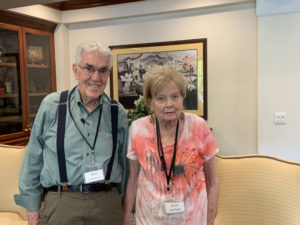
Were the RMMLA meetings very large?
Oh yes, it had people from all over the mountain west. We had AML sessions at the RMMLA every year, and they were very well attended. And I was not afraid to talk about the Book of Mormon as a text there. I based this paper on the ideas of Robert Scholes on the protocols of reading. So I took those ideas and applied them to the Book of Mormon. It is really quite exciting.
Being in the AML, I realized I didn’t need to apologize for what I had. And I could encourage people to look at the Book of Mormon from a scholarly viewpoint. It is a unique text, in that it tells you how to read it. There is the question, does the meaning come off of the page to the reader, or does the reader place meaning on the text? It is a dialectic between the two, and it is an unstable relationship. But if you add a third party to it, it becomes absolutely stable. And the Book of Mormon says you have to read this for the third party [God].
Was there anyone at BYU who was particularly encouraging of this idea of taking these Mormon ideas and putting them in an academic context?
Dick Cracroft, Gene England, Steven Sondrup, Levi (who wasn’t here at BYU, but was very close), Dick’s friend (what was his name? I can’t remember), and Bruce Young. Bruce Young is brilliant, he gave me some ideas in his discussion of the Odyssey, about telling stories.
That kind of ambiance created an exciting atmosphere at BYU.
You became the second president of AML in 1977. They held the second symposium, and they started doing the awards at that time. Do you know who came up with the idea of awards?
I don’t, but it was a very good idea!
Around that time I was Associate Academic VP, under Jeff Holland. At that time, BYU was given the responsibility of writing a biography of J. Reuben Clark. They gave that task to Michael Quinn, and I was told to oversee that task. The biography was not turning out the way that some people expected. I can’t remember how they solved it. But we gave an award for biography that year to that book. That is the only time I remember being involved in the awards.
After 1979 you weren’t on the AML board.
Yes, I didn’t participate as much after that. Not because I was not interested, but because so many other things got in the way. We were called on a mission to Raleigh, NC in 1986-89, and I was a stake president on campus, and chair of the English Department for a while in the early 1990s, which was a hard time. Do you want to see the bruises? Once I was standing by the window in the Chair’s office in the old JKHB on the 3rd floor, thinking over my problems, when Ed Geary walked by, and he said, “Neal, don’t jump, it’s not high enough!”
Tell me about being the BYU English Department Chair in 1991-1994.
That was a hard time. The hardest thing was trying to negotiate the world of BYU and the issues coming from Salt Lake. A general authority came to a stake conference when I was on a high council. I was talking to the Stake President, who was talking to the visiting general authority. He introduced me, and the general authority turned to me and said, “I came here because I wanted to talk to you.” He put his finger on my chest and said, “I have a stack of complaints on my desk about the BYU English Department, and I want you to do something about it.”
So you have that on one hand, and then you have reporters from the Chronicle of Higher Education and other newspapers on campus, waiting to see what is going to happen with the new hires their continuing status. So it is hard to be a good scholar and sit down and think about life in those situations.
Did you just get the one message from Salt Lake, or were there lots of messages?
That was just that one direct message, but there were plenty of other implied messages.
Can I ask who that general authority was?
No (laughs). (Ann says: “You can probably guess.”)
The Church has a small segment that thinks that all literature and art is for sweetness and light. So you have to deal with that, and that’s okay. You can say, yes, there is light. Real light! And there is sweetness, that you can taste, if you know how to read it.
But, the question is, how did politics affect the English department? It was hard to separate it. It was hard for me, I wouldn’t want to go back to that again.
Were you there when Gene England left (1998)?
Yes. Honestly, I don’t know too much about it [England being asked to leave the university]. It was not going through us. I may have been chair at the time, but I didn’t know anything about it. I was surprised, frankly.
He apologized to me once for something, and he said, “I’m sorry Neal, I was born with a limited judgment gene.” He acknowledged that his judgment sometimes may have not quite caught up with the things he really wanted to do.
Terryl Givens said that he thinks that he could sometimes be willfully naïve. He knew that some of the things he said could cause trouble, but he had faith that things would be okay.
Yes, that is a good way to put it. He had ideas, and thought something would be a good idea to do, and he would do it. The only issue I remember, when I was chair, was his appearance at a protest demonstration, something about a fence or something. And he came to me afterwards and apologized if he had caused me trouble. He was a really good man.
In reading the biography, I was surprised at how much Gene talked to Church General Authorities. Did you talk to General Authorities a lot?
No, fortunately I had the administration between us and the General Authorities. But I knew that the English Department was not a favorite of theirs.
President Holland had an academic background.
Oh yes, very much. He got his PhD in American Studies from Yale, with a dissertation on Mark Twain. We were back there years later for a summer seminar, and all I had to do was to mention Jeff Holland, and the faculty just lit up. He had a reputation among the faculty at Yale, and his study of Twain and his religion is really very good. I’ve heard many of the BYU faculty say that the Holland administration was the golden years at BYU. Because we were doing good things, and encouraged to do good things, and if someone was complaining, the administration was our place to lean on, they would help us. Those were good years.
Bruce Jorgensen was in the Department at that time.
Bruce Jorgensen was an ideal department member. He was a great teacher and a great writer, with wonderful ideas, not trying to push his ideas on anyone else. The stuff he wrote was so good. I remember one of his papers, he utilized the idea from classic literature, Aeneas, that when you invite someone over, you listen to their stories. Aeneas’s story was so dramatic, that his hostess [Dido] falls in love with him, so that when he does not stay with her, but goes on to finish his mission in Rome, that she burns herself on the fire when he leaves. So we need to pay attention to these stories, we live by them. Bruce was the source of that for me. I treasure him, he is the kindest person I have ever been around.
The debate that he had with Richard Cracroft over Mormon literature. Was it a . . . passionate debate?
Oh no, not at all. We agreed on almost everything. Bruce was freer in his gathering of Mormon expressions than I was, which was good, because I would have missed a lot of stuff. Their debate was a friendly debate.
Dick was unique, ripe with excitement and verve. He was a good friend. Dick and I were able to work together in wonderful ways. He was a born comic, he could have made a living from it, it came spontaneously to him. But he could also be very serious. He was one of the most significant influences on my life. All of the things that have our combined names went through both typewriters. The only real issue was whose turn it was to write the “soar”—the last paragraph, that has to “soar”.
What was the impetus to edit the book of young authors? [(with Richard Cracroft). 22 young Mormon Writers. Provo: Communications Workshop, 1975.]
That was an idea of Milo Baughman. He was a convert to the church, he was designer of fine furniture from North Carolina, and made piles of money. He married a Mormon girl, and then joined the Church himself, and came West with his money. He was always starting projects. He was a neighbor of ours, we became very good friends, and we talked about Mormon art, and that led him into that area. He taught as an adjunct for a while in the Department of Environmental Design. He said, “You guys should publish a book of new authors. And I thought about starting a publishing business.” So he created Communications Workshop, that started and ended with that book.
[We go through more names.] Do you remember Bela Pesco?
Yes, he was hard to pin down. I remember him as a student, most of these authors were students at BYU when we published it. He was a little older than other students, and he would go off into other tracks. We knew if he got involved, then boundaries would be pushed in unexpected directions.
Clifton Jolley?
We lived on the same street at one point. He was working for the Deseret News, but then he moved, and that was the last I knew of him.
Doug Thayer was a very good friend. I don’t know anyone who labored more with his writing. He worked it and worked it, writing countless drafts. It was very honest, good stuff.
Ed Geary is two people. One is Ed, the other is his wife, Janis. She is the opposite of Ed. Ed is quiet, subdued, solid. Janis was off the wall and ceiling, with all kinds of projects. I don’t know how they ever got together, but they are a perfect match. Ed is one of the wisest men I have ever been around. He was a great person to have in the department. He lives on his farm in Huntington now.
Elouise Bell?
She was one of those brilliant, wonderful people to have around. She was a great teacher. She kept things lively for us. We had an overly-sensitive new faculty member. In our first faculty meeting in the Fall, Elouise made a comment, “That person needs a clean pair of garments.” The kind of comment she would make! That person got up and left the meeting. She [the offended person] never liked the English department, she thought we were far too liberal. I don’t know what she meant by that, we were just being honest with the texts. She left to go to a different part of the university. Anyway, Elouise was lots of fun, she was willing to do anything. I remember she broke both ankles at a tour of a fire station. People were sliding down the poll, and she thought she would want to do that. And she broke both of her ankles.
[I mentioned that Elouise Bell married a woman after she retired from BYU.]
I am not surprised. I know she had some very close female friends.
Did you meet Karl Keller (a literary scholar at California State University at San Diego, who frequently published Mormon literature in Dialogue)?
No, I did not know him.
Who are your favorite authors?
I am teaching classes for a program here called Elder Quest. A senior citizen program, where they take retired faculty members and give us a chance to talk. I have taught a couple, which has helped me to stay alive. My favorite authors today are Mark Twain. I also really enjoy Lauren Isley, a historical anthropologist, at Pittsburgh. A modern-day Thoreau. Rights in a religious vein the way that Thoreau did.
I am enjoying studying my ancestors’ journals and diaries, and writing about them in his head.
[End]
